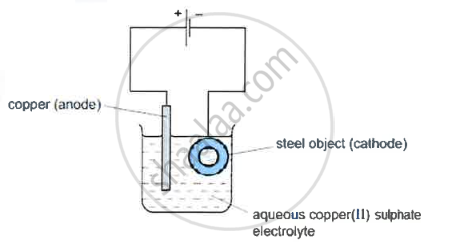Advertisements
Advertisements
Question
Name the metallic ions that should be present in the electrolyte when an article made of copper is to be electroplated with silver.
Solution
Ag+ and Na+
APPEARS IN
RELATED QUESTIONS
Name the following :
The process of coating of iron with zinc
State one relevant observation for the following:
At the anode when aqueous copper sulphate solution is electrolysed using copper electrodes.
Copy and complete the following table:
| Anode | Electrolyte | |
| Purification of copper |
Choose the correct answer from the options given below:
The electrolyte used for electroplating an article with silver is
A. Silver nitrate solution
B. Silver cyanide solution
C. Sodium argentocyanide solution
D. Nickel sulfate solution
The following question relate to the electroplating of an article with silver.
What ions must be present in the electrolyte?
The following question relate to the electroplating of an article with silver.
What should be the nature of the anode?
The electrolyte used for electroplating an article with silver is ______.
Copy and complete the following table :
| Anode | Electrolyte | |
| Purification of copper |
What ions must be present in a solution used for electroplating a particular metal?
Electroplating steel objects with silver involves a three-step process.
Step 1: A coating of copper is applied to the object.
Step 2: A coating of nickel is applied to the object.
Step 3: The coating of silver is applied to the object.
-
- A diagram of the apparatus used for step 1 is shown

- The chemical process taking place on the surface of the object is \[\ce{Cu^2+(aq) + 2e- ->Cu(s)}\]
What is the observation seen on the surface of the object? - Explain why the concentration of copper ions in the electrolyte remains constant throughout step 1.
- The chemical process taking place on the surface of the object is \[\ce{Cu^2+(aq) + 2e- ->Cu(s)}\]
- A diagram of the apparatus used for step 1 is shown
- Give two changes which would be needed in order to coat nickel on to the object in step 2.
- Write down the reaction taking place at the positive electrode during step 3.
